Search Result
Results for "
oxidative injury
" in MedChemExpress (MCE) Product Catalog:
1
Biochemical Assay Reagents
| Cat. No. |
Product Name |
Target |
Research Areas |
Chemical Structure |
-
- HY-N2565
-
|
|
HIV Protease
Apoptosis
|
Infection
|
|
Rosamultin is a 19 α-hydroxyursane-type triterpenoid isolated from Potentilla anserina L. Rosamultin has inhibitory effects against HIV-1 protease . Rosamultin has the potential for treating H2O2-induced oxidative stress injury through its antioxidant and antiapoptosis effects .
|
-

-
- HY-44307
-
|
|
Ferroptosis
|
Cancer
|
|
84-B10 is a 3-phenylglutaric acid derivative. 84-B10 inhibits cisplatin (HY-17394) induced tubular ferroptosis. 84-B10 attenuates cisplatin-induced mitochondrial damage and oxidative stress. 84-B10 ameliorates cisplatin-induced acute kidney injury (AKI) .
|
-
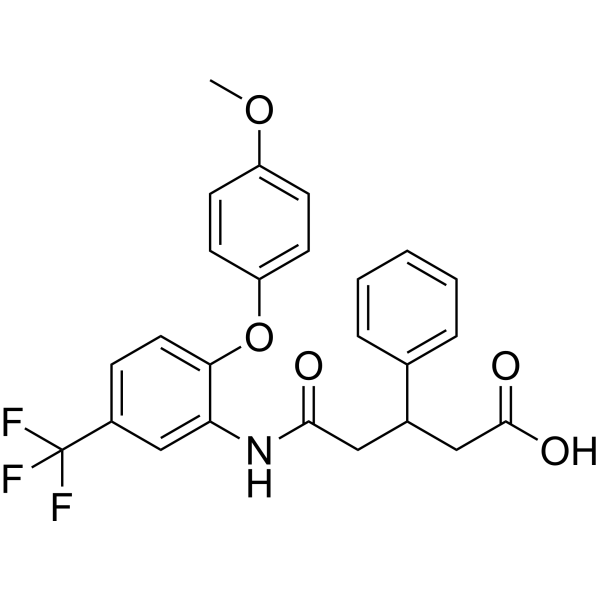
-
- HY-162378
-
-
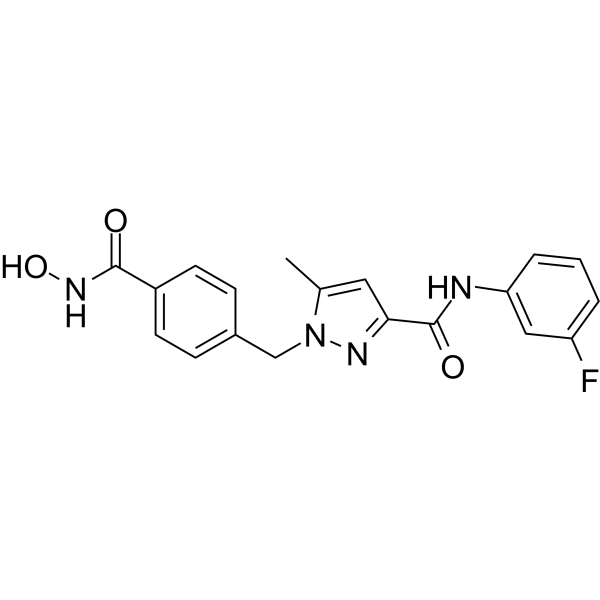
-
- HY-114520
-
-

-
- HY-P5762A
-
|
PNX-14 TFA
|
GnRH Receptor
|
Cardiovascular Disease
Neurological Disease
Metabolic Disease
Inflammation/Immunology
|
|
Phoenixin-14 (PNX-14) TFA, a BBB-penatrable neuropeptide, has anxiolytic, cardioprotective and neuroprotective effect. Phoenixin-14 TFA can regulate pituitary gonadotrophin secretion by upregulating the GnRH receptor mRNA. Phoenixin-14 TFA stimulates insulin secretion. Phoenixin-14 TFA also protects mice from ischemia/reperfusion (IR) injury. PNX-14 TFA prevents oxidative stress by reducing ROS and increasing GSH .
|
-
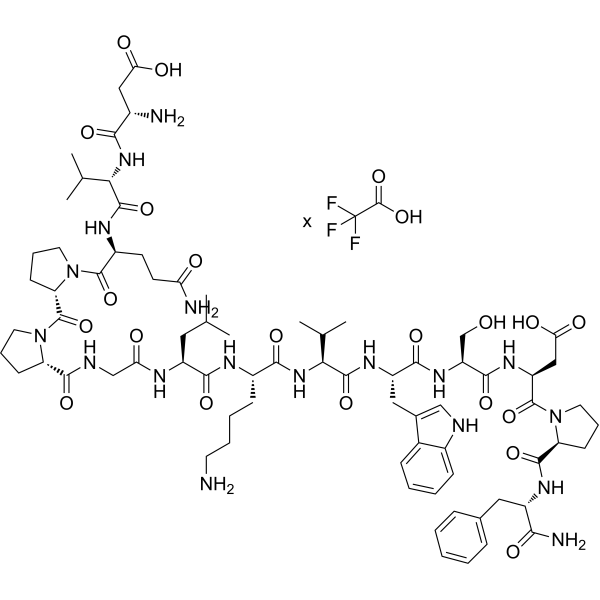
-
- HY-138454
-
|
Mercaptoethylguanidine hemisulfate
|
NO Synthase
|
Inflammation/Immunology
|
|
MEG (Mercaptoethylguanidine) hemisulfate is a potent and selective inhibitor of the inducible NO synthase (iNOS), with EC50s of 11.5, 110, and 60 μM for iNOS, ecNOS, and bNOS respectively in tissue homogenates. MEG hemisulfate is also a potent scavenger of peroxynitrite and inhibits peroxynitrite-induced oxidative processes. MEG hemisulfate has a protective effect in many experimental models of inflammation, including ischemia/reperfusion injury, periodontitis, hemorrhagic shock, inflammatory bowel disease, and endotoxic and septic shock .
|
-

-
- HY-P0125
-
-
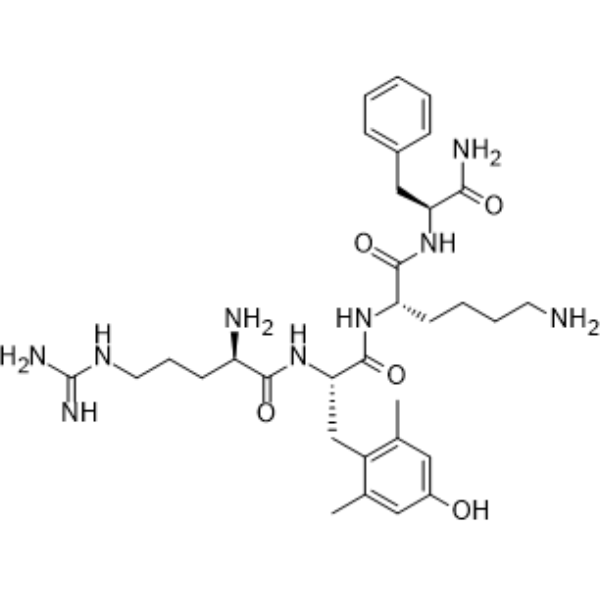
-
- HY-P0107
-
|
|
|
|
|
RC-3095 is a bombesin/gastrin releasing peptide receptor (GRPR) antagonist . RC-3095 exerts protective effects by reducing gastric oxidative injury in the arthritic mice .
|
-
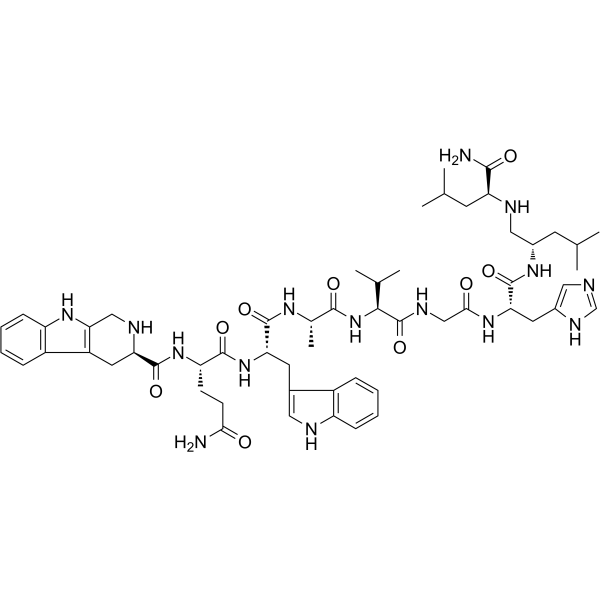
-
- HY-P0107A
-
|
|
Bombesin Receptor
|
Inflammation/Immunology
|
|
RC-3095 TFA is a selective bombesin/gastrin releasing peptide receptor (GRPR) antagonist . RC-3095 TFA exerts protective effects by reducing gastric oxidative injury in the arthritic mice .
|
-
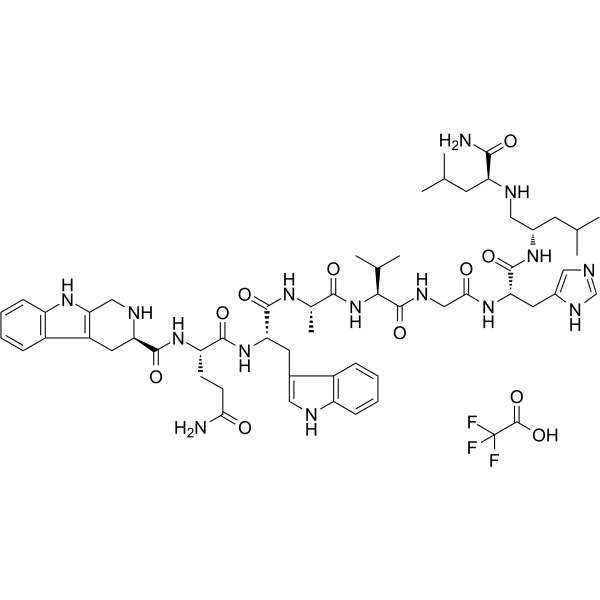
-
- HY-E70008
-
|
|
Sirtuin
|
Inflammation/Immunology
|
|
Lumbokinase capsules attenuates myocardial ischemia-reperfusion (I-R) injury through the activation of Sirt1 signaling, and thus enhances autophagic flux and reduces I-R-induced oxidative damage, inflammation and apoptosis .
|
-

-
- HY-N0676
-
|
|
Influenza Virus
|
Infection
Cancer
|
|
Dehydroandrographolide can be extracted from herbal medicine Andrographis paniculata Nees. Dehydroandrographolide reduces oxidative stress in LPS-induced acute lung injury by inactivating iNOS. Dehydroandrographolide has anti-infective activity .
|
-
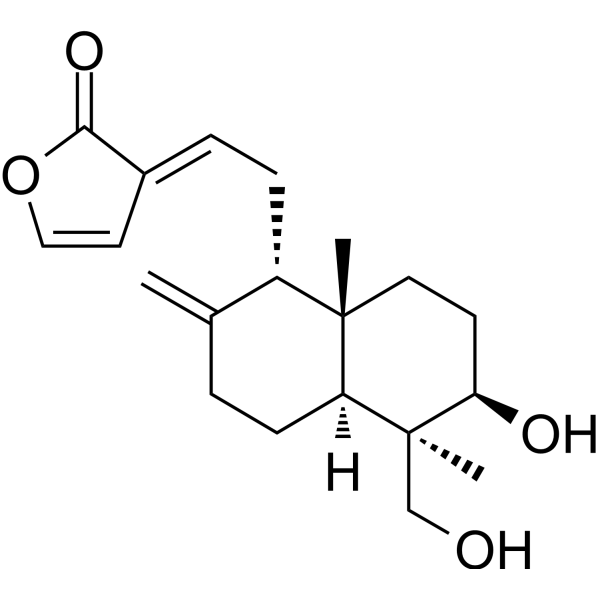
-
- HY-N12277
-
|
|
Apoptosis
|
Neurological Disease
|
|
Celosin K (compound 8) can be isolated from the seeds of Semen Celosiae. Celosin K is a potent inhibitor of neuron injury elicited by t-BHP. Celosin K inhibits oxidative stress and apoptosis, and acts of autophagy .
|
-
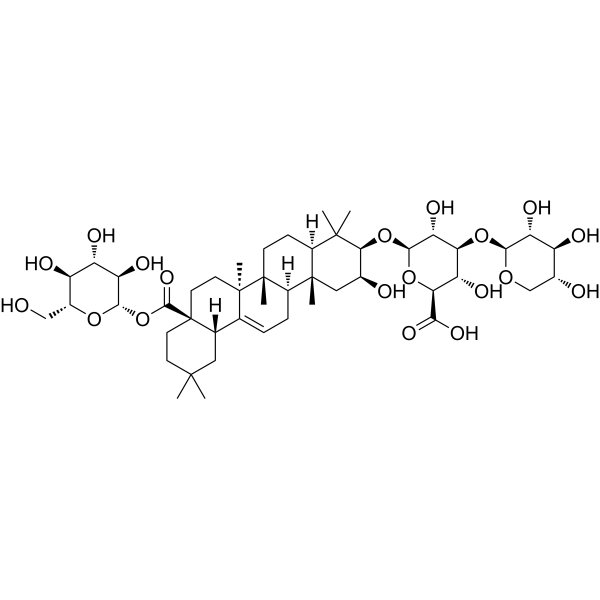
-
- HY-N7513
-
|
|
Drug Metabolite
|
Cardiovascular Disease
|
|
Homovanillyl alcohol is a biological metabolite of Hydroxytyrosol. Hydroxytyrosol is a phenolic compound that is present in virgin olive oil (VOO) and wine. Homovanillyl alcohol protects red blood cells (RBCs) from oxidative injury and has protective effect on cardiovascular disease .
|
-
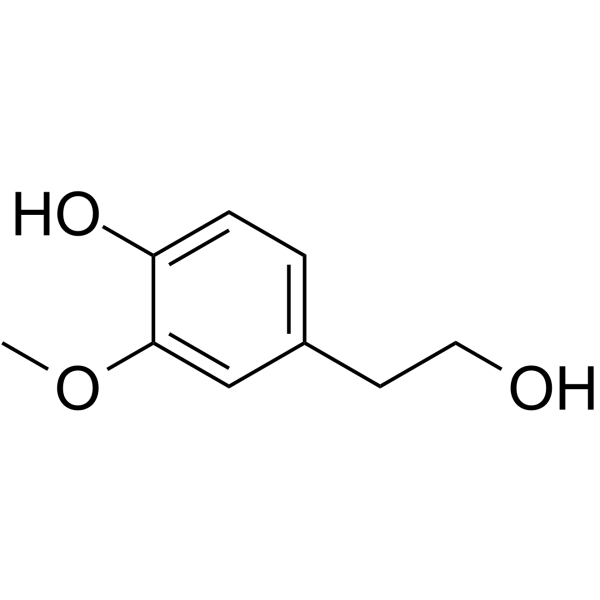
-
- HY-N7133
-
|
N-Phenylaniline hydrochloride
|
Fungal
Bacterial
|
Others
|
|
Diphenylamine is a common structure of nonsteroidal anti-inflammatory drugs (NSAIDs) to uncouple mitochondrial oxidative phosphorylation and to cause a decrease in hepatocellular ATP content and hepatocyte injury. Diphenylamine is used as an industrial antioxidant, dye mordant and is also applied in agriculture as a fungicide and antihelmintic .
|
-

-
- HY-126042
-
|
(±)-Lisophylline
|
Others
|
Metabolic Disease
Inflammation/Immunology
|
|
(±)-Lisofylline ((±)-Lisophylline) is the racemate of Lisofylline. Lisofylline inhibits the generation of phosphatidic acid and free fatty acids. Lisofylline also blocks the release of pro-inflammatory cytokines in oxidative tissue injury, in response to cancer chemotherapy and in experimental sepsis. Lisofylline can be used for Type 1 diabetes research .
|
-
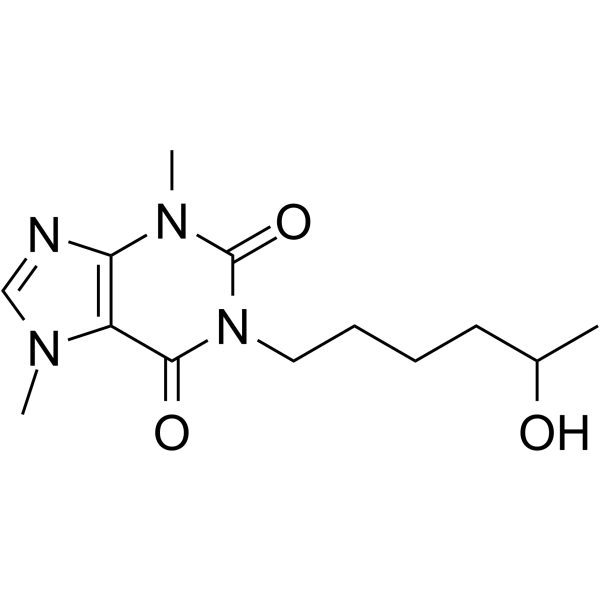
-
- HY-150055
-
|
|
NO Synthase
|
Inflammation/Immunology
|
|
iNOs-IN-3 (Compound 2d) is an orally active nitric oxide synthase (iNOS) inhibitor (IC50=3.342 µM). iNOs-IN-3 shows anti-inflammatory activity and can be used in LPS-induced acute lung injury (ALI) research .
|
-
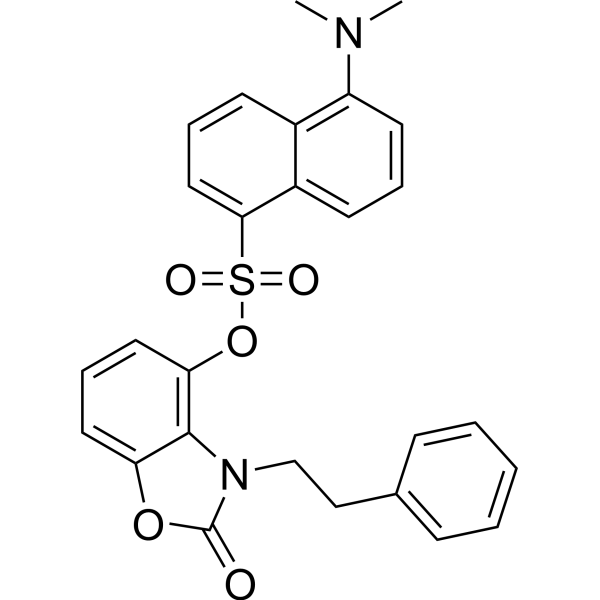
-
- HY-149586
-
|
|
Reactive Oxygen Species
|
Others
|
|
ROS-IN-2 (compound 85) is a seco-lupane triterpenoid derivative. ROS-IN-2 blocks ROS production and protects mitochondria from damage by inhibiting excessive production of oxidative stressors. ROS-IN-2 can be used for myocardial ischemia/reperfusion (MI/R) injury research .
|
-

-
- HY-W105101
-
|
|
Others
|
Others
|
|
3,5-Dibromotyrosine is a product of protein oxidation by eosinophil peroxidase .
|
-

-
- HY-N0615
-
|
Sanchinoside R1; Sanqi glucoside R1
|
Amyloid-β
Apoptosis
|
Others
|
|
Notoginsenoside R1 (Sanchinoside R1), a saponin, is isolated from P. notoginseng. Notoginsenoside R1 exhibits anti-oxidation, anti-inflammatory, anti-angiogenic, and anti-apoptosis activities. Notoginsenoside R1 provides cardioprotection against ischemia/reperfusion (I/R) injury. Notoginsenoside R1 also provides neuroprotection in H2O2-induced oxidative damage in PC12 cells .
|
-
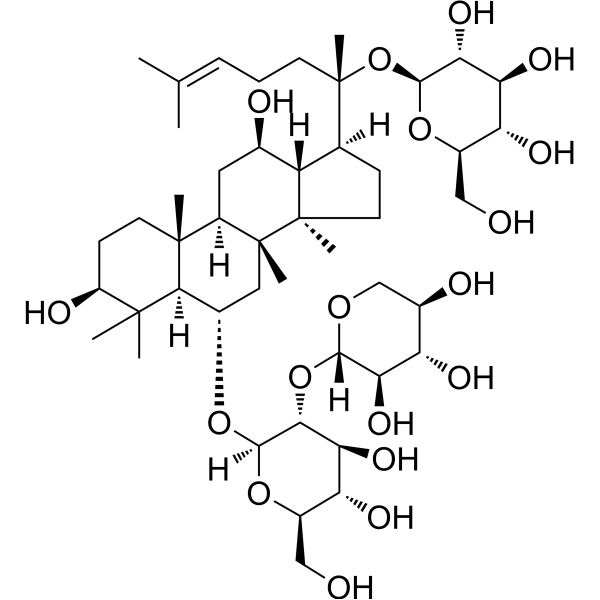
-
- HY-N4037
-
|
(-)-Homopterocarpin; 3,9-Dimethoxypterocarpan
|
Monoamine Oxidase
|
Inflammation/Immunology
|
|
Homopterocarpin is an isoflavonoid that can be isolated from Pterocarpus erinaceus. Homopterocarpin has hepatoprotective and antioxidant properties. Homopterocarpin is a competitive reversible inhibitor of human monoamine oxidase-B with an IC50 and a Ki of 0.72 and 0.21 μM for hMAO-B, respectively. Homopterocarpin can be used for the research of liver injury and oxidative stress .
|
-
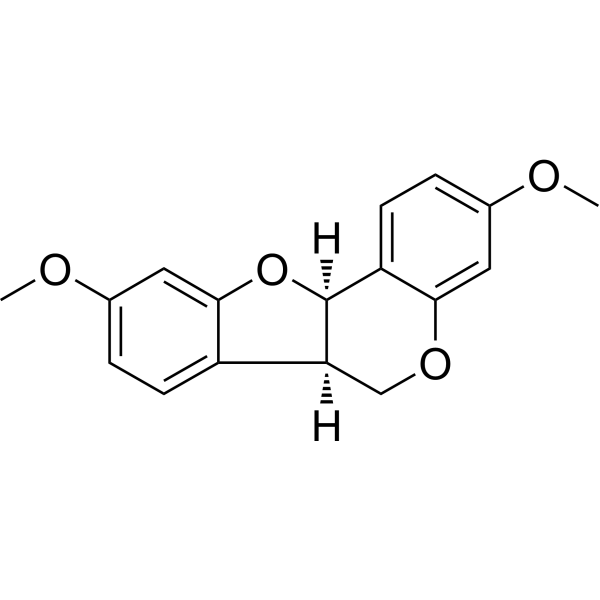
-
- HY-128423A
-
|
Acetylisovaleryltylosin
|
Antibiotic
Bacterial
NF-κB
Apoptosis
|
Infection
Inflammation/Immunology
Cancer
|
|
Tylvalosin (Acetylisovaleryltylo?sin) is an orally active, broad-spectrum macrolide antibiotic with antimicrobial activity. Tylvalosin is an antiviral agent used to study PRRSV infection. Tylvalosin induces apoptosis. Tylvalosin also has anti-inflammatory activity, alleviates oxidative stress, and alleviates acute lung injury by inhibiting NF-κB activation .
|
-

-
- HY-163092
-
|
|
MAGL
Necroptosis
|
Inflammation/Immunology
|
|
LEI-515 is a first-in-class peripherally restricted, reversible MAGL inhibitor. LEI-515 increases 2-AG levels in peripheral organs, but not mouse brain. LEI-515 attenuated liver necrosis, oxidative stress and inflammation in a CCl4-induced acute liver injury model .
|
-
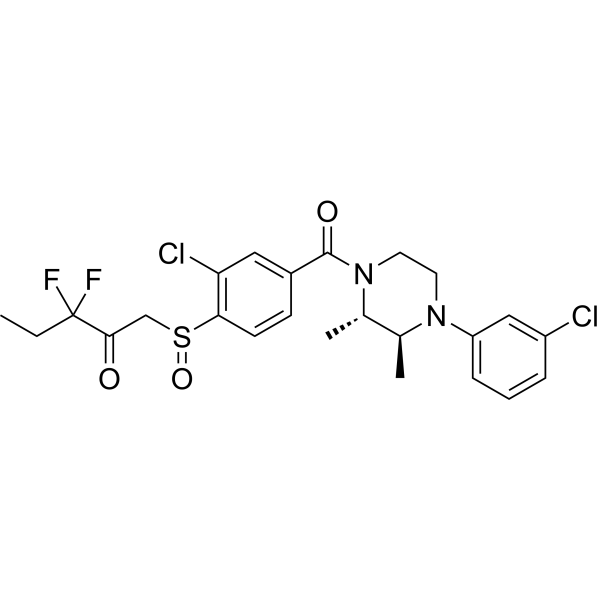
-
- HY-101364
-
|
|
mGluR
NF-κB
ERK
Akt
|
Cardiovascular Disease
Inflammation/Immunology
|
|
CHPG is a selective mGluR5 agonist, and attenuates SO2-induced oxidative stress and inflammation through TSG-6/NF-κB pathway in BV2 microglial cells . CHPG protects against traumatic brain injury (TBI) in vitro and in vivo by activation of the ERK and Akt signaling pathways .
|
-
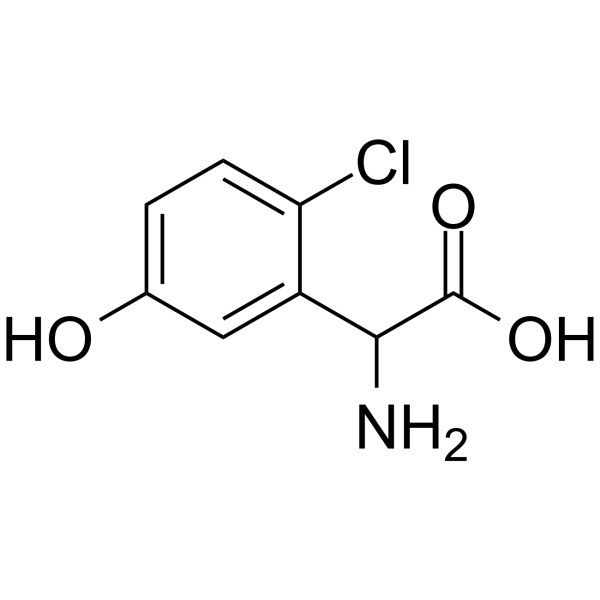
-
- HY-101364A
-
|
|
mGluR
NF-κB
ERK
Akt
|
Neurological Disease
Inflammation/Immunology
|
|
CHPG sodium salt is a selective mGluR5 agonist, and attenuates SO2-induced oxidative stress and inflammation through TSG-6/NF-κB pathway in BV2 microglial cells . CHPG sodium salt protects against traumatic brain injury (TBI) in vitro and in vivo by activation of the ERK and Akt signaling pathways. .
|
-

-
- HY-P0125B
-
|
MTP-131 triacetate; RX-31 triacetate; SS-31 triacetate
|
Mitochondrial Metabolism
|
Cardiovascular Disease
Neurological Disease
Inflammation/Immunology
|
|
Elamipretide triacetate (MTP-131 triacetate; RX-31 triacetate; SS-31 triacetate) is Elamipretide triacetate form of Elamipretide (HY-P0125). Elamipretide triacetate is a mitochondria-targeting peptide, which ameliorates myocardial infarction, improves the renal function and protects neurons form inflammatory and oxidative stress injury .
|
-
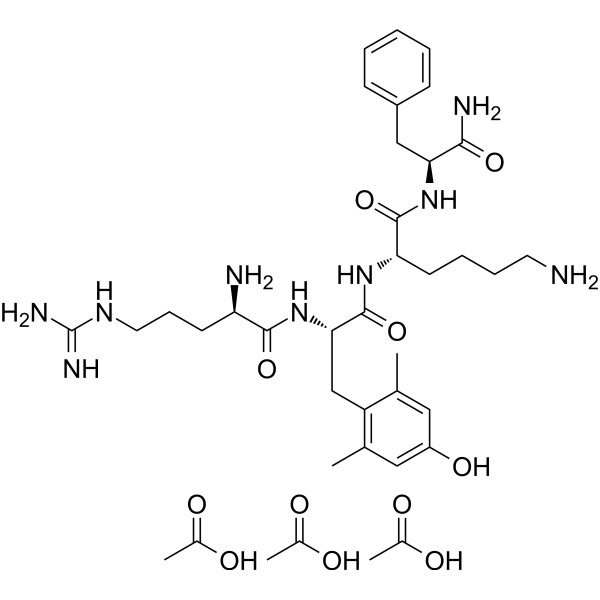
-
- HY-P0125A
-
-
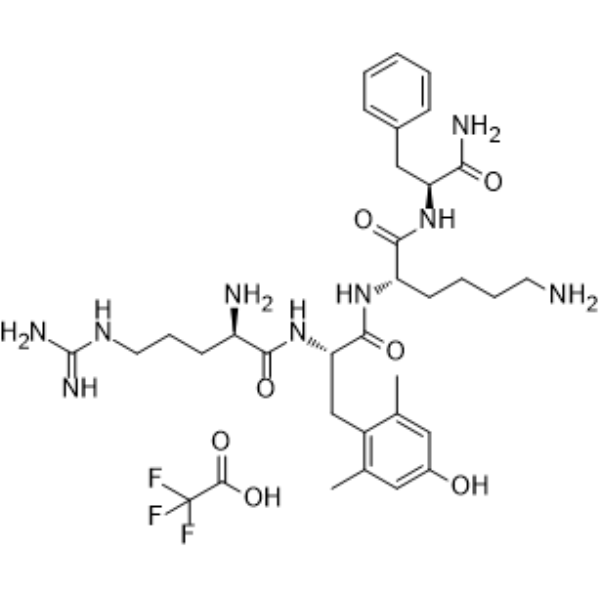
-
- HY-128423
-
|
Acetylisovaleryltylosin tartrate
|
Antibiotic
Bacterial
NF-κB
Apoptosis
|
Infection
Inflammation/Immunology
|
|
Tylvalosin (Acetylisovaleryltylosin) tartrate is an orally active, broad-spectrum macrolide antibiotic with antimicrobial activity. Tylvalosin tartrate is an antiviral agent useful in studying PRRSV infection. Tylvalosin tartrate induces apoptosis. Tylvalosin tartrate also has anti-inflammatory activity, relieves oxidative stress, and alleviates acute lung injury by inhibiting NF-κB activation .
|
-

-
- HY-112597A
-
|
REN001; HPP593
|
PPAR
|
Inflammation/Immunology
|
|
Mavodelpar (REN001) is a selective PPARδ agonist. Mavodelpar suppresses glomerular injury and renal fibrosis. Mavodelpar can be used for the research of primary mitochondrial myopathies (PMM) and long-chain fatty acid oxidation disorders (LC-FAOD) . Mavodelpar is a click chemistry reagent, it contains an Alkyne group and can undergo copper-catalyzed azide-alkyne cycloaddition (CuAAc) with molecules containing Azide groups.
|
-

-
- HY-120501
-
B022
4 Publications Verification
|
NF-κB
|
Inflammation/Immunology
|
|
B022 is a potent and selective NF-κB-inducing kinase (NIK) inhibitor (Ki of 4.2 nM; IC50=15.1 nM). B022 protects liver from toxin-induced inflammation, oxidative stress, and injury . B022 is a click chemistry reagent, it contains an Alkyne group and can undergo copper-catalyzed azide-alkyne cycloaddition (CuAAc) with molecules containing Azide groups.
|
-
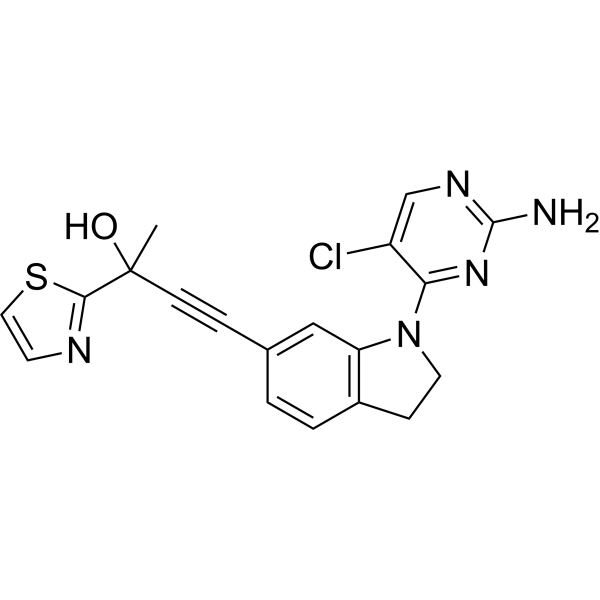
-
- HY-120912
-
|
|
Keap1-Nrf2
Glutathione Peroxidase
|
Inflammation/Immunology
|
|
Gingerenone A is a Nrf2-Gpx4 activator with anti-breast-cancer properties. Gingerenone A results a delayed G2/M in cancer cells, following oxidative stress and senescence responses. Gingerenone A also alleviates ferroptosis in secondary liver injury (SLI) in dextran sodium sulfate (DSS)-induced colitis mice. Gingerenone A can be isolated from Zingiber officinale .
|
-

-
- HY-126124
-
AP39
2 Publications Verification
|
Others
|
Cardiovascular Disease
Neurological Disease
|
|
AP39 is a triphenylphosphonium derivatised anethole dithiolethione and mitochondria-targeting hydrogen sulfide (H2S) donor. AP39 increases intracellular H2S levels. AP39 exerts cytoprotective effects and maintains mitochondrial DNA integrity under oxidative stress conditions. AP39 protects against myocardial reperfusion injury in mice model and has the potential for Alzheimer's disease research .
|
-
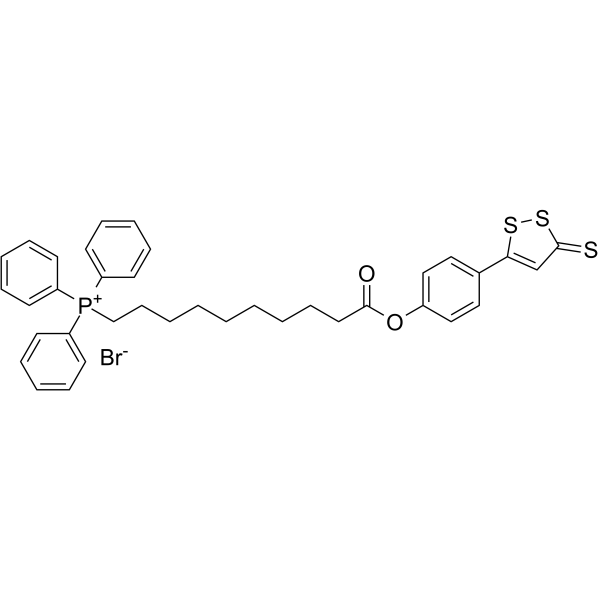
-
- HY-12119
-
|
|
NO Synthase
|
Neurological Disease
Inflammation/Immunology
|
|
GW274150 is a potent, selective, orally active and NADPH-dependent inhibitor of human inducible nitric oxide synthase (iNOS) (IC50=2.19 μM; Kd=40 nM) and rat iNOS (ED50=1.15 μM). GW274150 also displays less potency for both humans or rats endothelial NOS (eNOS) and neuronal NOS (nNOS). GW274150 exerts a protective role in an acute model of lung injury inflammation .
|
-
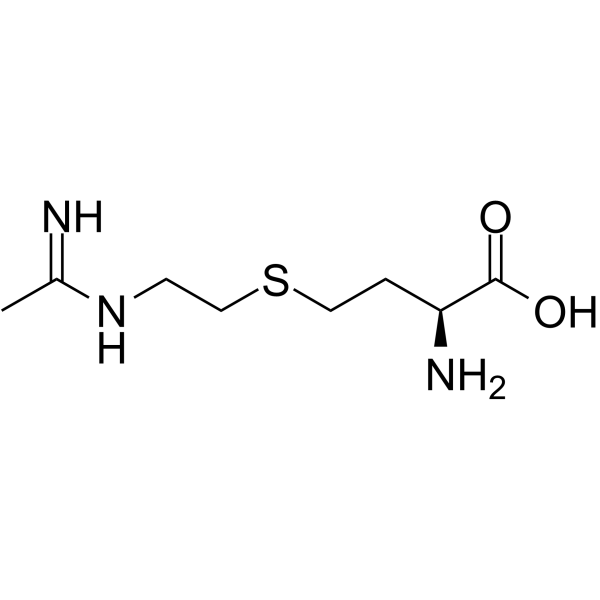
-
- HY-12119A
-
|
|
NO Synthase
|
Neurological Disease
Inflammation/Immunology
|
|
GW274150 phosphate is a potent, selective, orally active and NADPH-dependent inhibitor of human inducible nitric oxide synthase (iNOS) (IC50=2.19 μM; Kd=40 nM) and rat iNOS (ED50=1.15 μM). GW274150 phosphate displays less potency for both humans or rats endothelial NOS (eNOS) and neuronal NOS (nNOS). GW274150 phosphate exerts a protective role in an acute model of lung injury inflammation .
|
-

-
- HY-12119B
-
|
|
NO Synthase
|
Neurological Disease
Inflammation/Immunology
|
|
GW274150 (dihydrochloride) is a potent, selective, orally active and NADPH-dependent inhibitor of human inducible nitric oxide synthase (iNOS) (IC50=2.19 μM; Kd=40 nM) and rat iNOS (ED50=1.15 μM). GW274150 (dihydrochloride) displays less potency for both humans or rats endothelial NOS (eNOS) and neuronal NOS (nNOS). GW274150 (dihydrochloride) exerts a protective role in an acute model of lung injury inflammation .
|
-
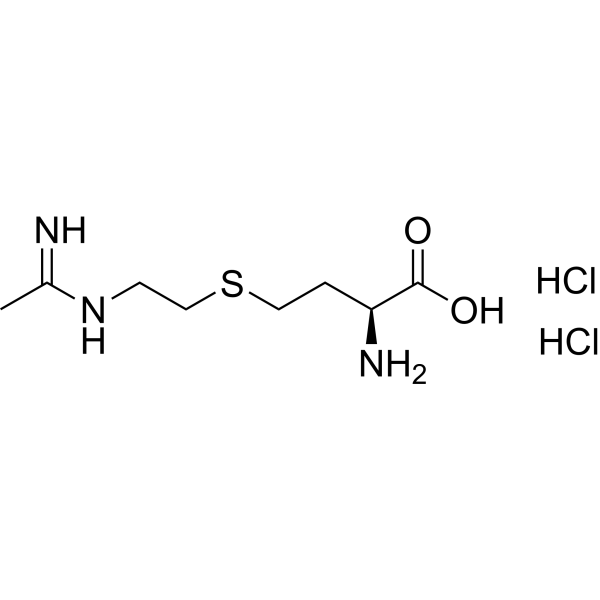
-
- HY-108351
-
|
|
Necroptosis
|
Cardiovascular Disease
|
|
IM-54 is a selective inhibitor of oxidative stress-induced necrosis. IM-54 shows potent inhibitory activity against H2O2-induced necrosis. IM-54 acts as a potential cardioprotective agent and biological tool for investigating the molecular mechanisms of cell death .
|
-
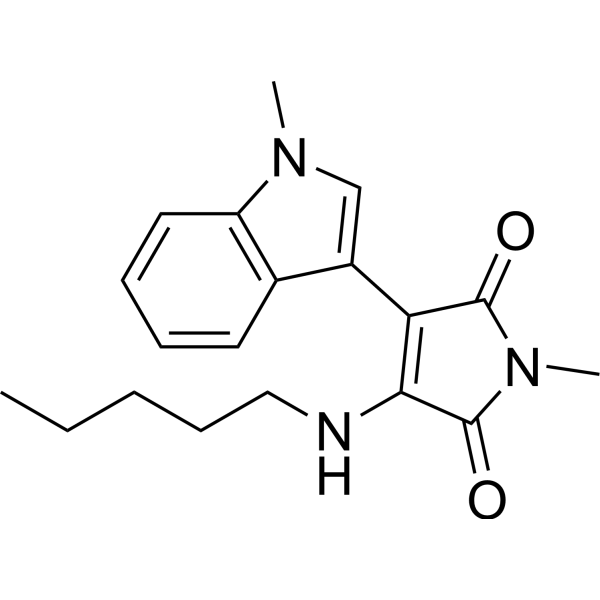
-
- HY-N0164
-
Matrine
Maximum Cited Publications
12 Publications Verification
Matridin-15-one; Vegard; α-Matrine
|
PINK1/Parkin
Opioid Receptor
Autophagy
Mitophagy
Ferroptosis
Apoptosis
|
Inflammation/Immunology
Cancer
|
|
Matrine (Matridin-15-one) is an alkaloid found in plants from the Sophora genus that can act as a kappa opioid receptor and u-receptor agonist. Matrine has a variety of pharmacological effects, including anti-cancer, anti-oxidative stress, anti-inflammation and anti-apoptosis effects. Matrine is potential in the research of disease like human non-small cell lung cancer, hepatoma, papillary thyroid cancer and acute kidney injury (AKI) .
|
-

-
- HY-N8931
-
|
Lithospermic acid monomethyl ester
|
Akt
|
Neurological Disease
|
|
Monomethyl lithospermate activates the PI3K/AKT pathway, which plays a protective role in nerve injury. Monomethyl lithospermate can improve the survival ability of SHSY-5Y cells, inhibit the breakdown of mitochondrial membrane potential (MMOP) and inhibit cell apoptosis. Monomethyl lithospermate also reduced the level of oxidative stress in the brain tissue of rats with middle artery occlusion (MCAO) and improved nerve damage in rats with ischemic stroke (IS) .
|
-

-
- HY-N0061
-
|
|
Reactive Oxygen Species
|
Neurological Disease
|
|
Ethyl ferulate, a naturally lipophilic derivative of ferulic acid originally derived from Rhizoma Chuanxiong, induces heme oxygenase-1 (HO-1) and protects rat neurons against oxidative stress . Ethyl ferulate also protects neurons against amyloid β peptide (1-42)-induced oxidative stress and neurotoxicity .
|
-
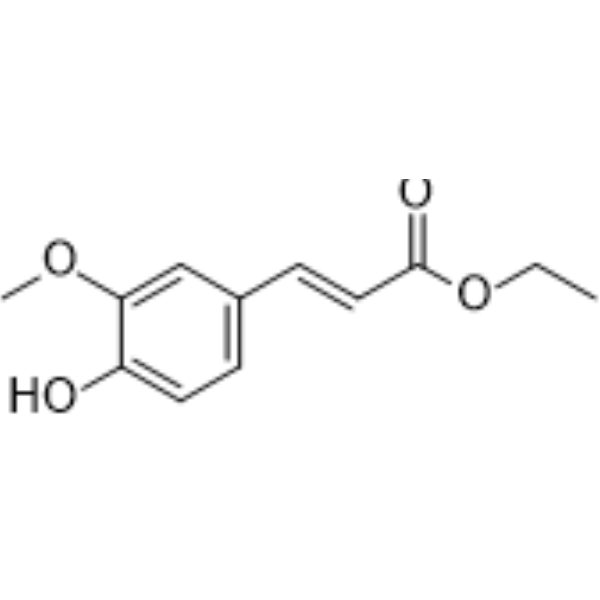
-
- HY-143243
-
|
|
Apoptosis
NF-κB
Keap1-Nrf2
Reactive Oxygen Species
|
Cardiovascular Disease
|
|
Antioxidant agent-5 (compound D-6) is a potent antioxidant agent. Antioxidant agent-5 can inhibit oxLDL (oxidized low-density lipoprotein)-induced apoptosis and the expression of ICAM-1 and VCAM-1 in VECs. Antioxidant agent-5 suppresses oxLDL-induced increase of ROS level and nuclear translocation of NF-κB. Antioxidant agent-5 protects against oxLDL-induced endothelial injury by activating Nrf2/HO-1 anti-oxidation pathway .
|
-
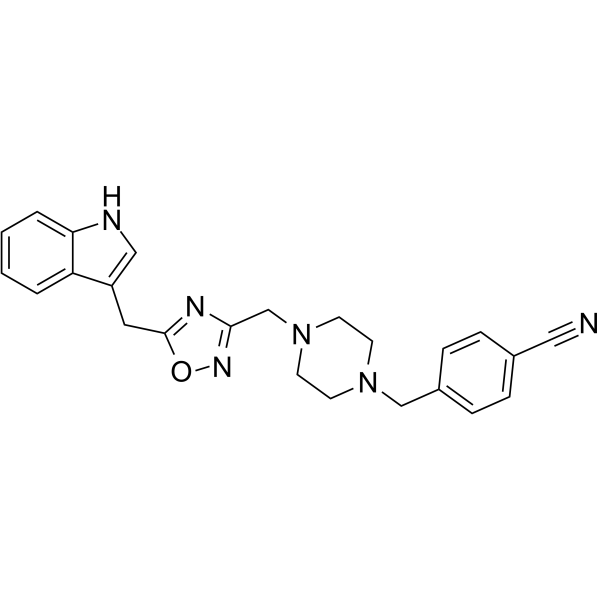
-
- HY-W016034
-
|
p-Acetamidophenyl β-D-glucuronide sodium salt; p-AAPG sodium salt
|
Others
|
Infection
|
|
Acetaminophen glucuronide is a safe and effective
antipyretic analgesic. Acetaminophen glucuronide is potentially toxic to liver
and kidney .
|
-
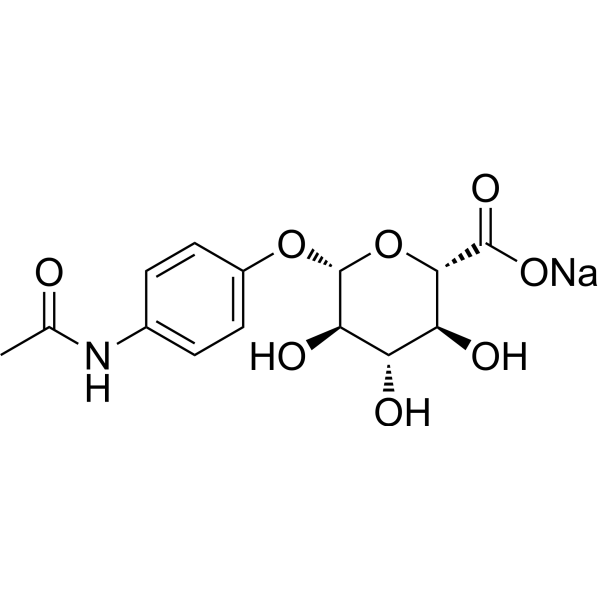
-
- HY-N1441
-
Afzelin
2 Publications Verification
Kaempferol-3-O-rhamnoside
|
|
|
|
Afzelin (Kaempferol-3-O-rhamnoside)It is a flavonol glycoside that has anti-inflammatory, anti-oxidative stress response, anti-apoptotic, and anti-cardiac cytotoxic effects. AfzelinIt can reduce mitochondrial damage, enhance mitochondrial biosynthesis, and reduce mitochondria-related proteins. Parkinand PTENinduced putative kinase 1 (putative kinase 1)s level. AfzelinCan be improved D-galactosamine(GalN)/LPSSurvival rate of mice treated with doxorubicin prophylaxis (HY-15142A)Induced cardiotoxicity and scopolamine (HY-N0296)-induced neurological injury. AfzelinAlso inhibits asthma and allergies caused by ovalbumin .
|
-

-
- HY-151487
-
|
|
Sirtuin
|
Neurological Disease
Metabolic Disease
Cancer
|
|
CypD-IN-3 is a potent and subtype-selective cyclophilin D (CypD) inhibitor. CypD-IN-3 has CypD affinity with an IC50 value of 0.01 μM. CypD-IN-3 can be used for the research of several diseases including oxidative stress, neurodegenerative disorders, liver diseases, aging, autophagy and diabetes .
|
-

-
- HY-151488
-
|
|
Sirtuin
|
Neurological Disease
Metabolic Disease
Cancer
|
|
CypD-IN-4 is a potent and subtype-selective cyclophilin D (CypD) inhibitor. CypD-IN-4 has CypD affinity with an IC50 value of 0.057 μM. CypD-IN-4 can be used for the research of several diseases including oxidative stress, neurodegenerative disorders, liver diseases, aging, autophagy and diabetes .
|
-
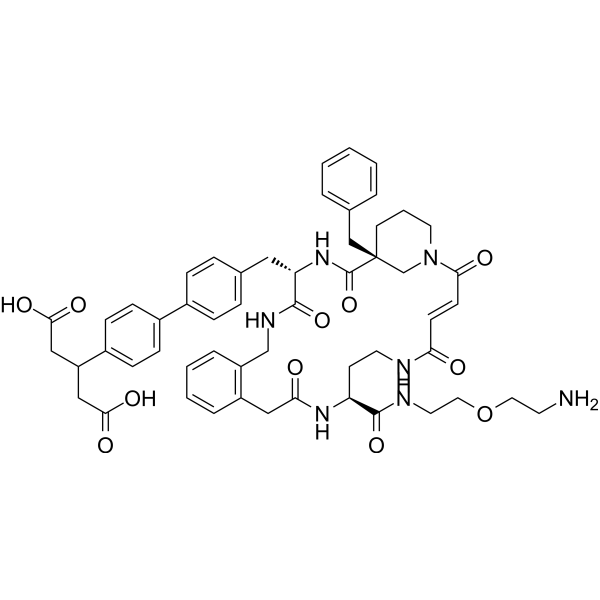
-
- HY-107666
-
-
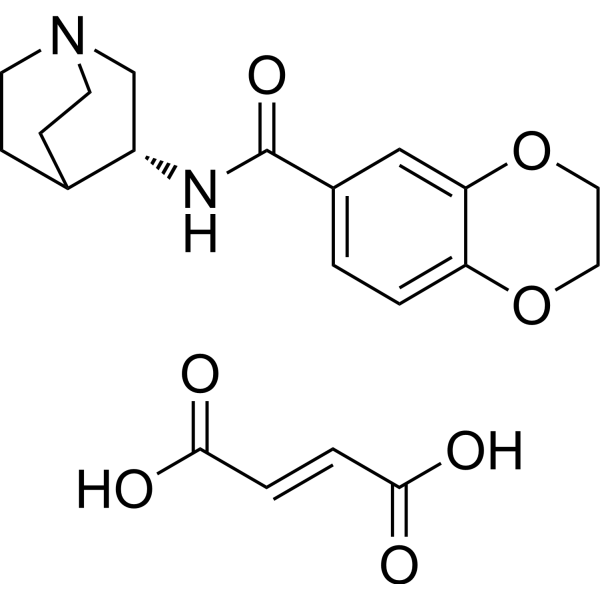
-
- HY-151489
-
|
|
Sirtuin
|
Neurological Disease
Metabolic Disease
Cancer
|
|
CypD-IN-1 is a potent and subtype-selective cyclophilin E (CypE) inhibitor. CypD-IN-1 has CypE affinity with IC50 and Ki values of 0.013 μM and 0.072 μM, respectively. CypD-IN-1 can be used for the research of several diseases including oxidative stress, neurodegenerative disorders, liver diseases, aging, autophagy and diabetes .
|
-
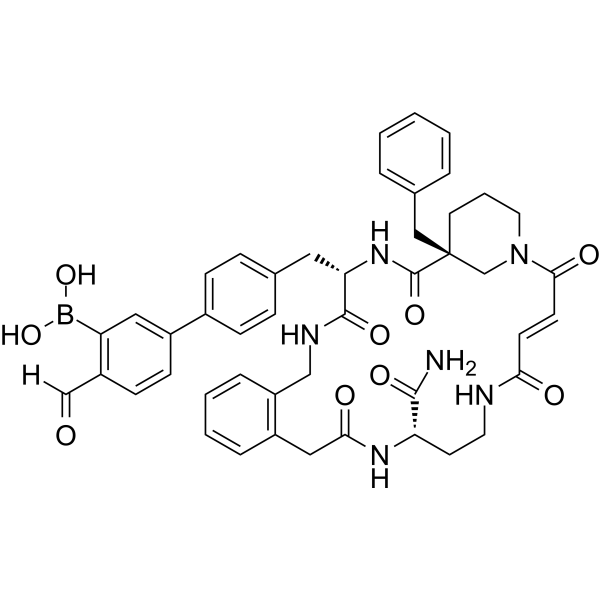
| Cat. No. |
Product Name |
Type |
-
- HY-E70008
-
|
|
Biochemical Assay Reagents
|
|
Lumbokinase capsules attenuates myocardial ischemia-reperfusion (I-R) injury through the activation of Sirt1 signaling, and thus enhances autophagic flux and reduces I-R-induced oxidative damage, inflammation and apoptosis .
|
| Cat. No. |
Product Name |
Target |
Research Area |
-
- HY-P0107A
-
|
|
Bombesin Receptor
|
Inflammation/Immunology
|
|
RC-3095 TFA is a selective bombesin/gastrin releasing peptide receptor (GRPR) antagonist . RC-3095 TFA exerts protective effects by reducing gastric oxidative injury in the arthritic mice .
|
-
- HY-P0125B
-
|
MTP-131 triacetate; RX-31 triacetate; SS-31 triacetate
|
Mitochondrial Metabolism
|
Cardiovascular Disease
Neurological Disease
Inflammation/Immunology
|
|
Elamipretide triacetate (MTP-131 triacetate; RX-31 triacetate; SS-31 triacetate) is Elamipretide triacetate form of Elamipretide (HY-P0125). Elamipretide triacetate is a mitochondria-targeting peptide, which ameliorates myocardial infarction, improves the renal function and protects neurons form inflammatory and oxidative stress injury .
|
-
- HY-P5762A
-
|
PNX-14 TFA
|
GnRH Receptor
|
Cardiovascular Disease
Neurological Disease
Metabolic Disease
Inflammation/Immunology
|
|
Phoenixin-14 (PNX-14) TFA, a BBB-penatrable neuropeptide, has anxiolytic, cardioprotective and neuroprotective effect. Phoenixin-14 TFA can regulate pituitary gonadotrophin secretion by upregulating the GnRH receptor mRNA. Phoenixin-14 TFA stimulates insulin secretion. Phoenixin-14 TFA also protects mice from ischemia/reperfusion (IR) injury. PNX-14 TFA prevents oxidative stress by reducing ROS and increasing GSH .
|
-
- HY-P0125
-
-
- HY-P0125A
-
-
- HY-P3397
-
|
|
Peptides
|
Cancer
|
|
JV-1-36 is a growth hormone-releasing hormone (GHRH) antagonist. JV-1-36 inhibits the production of reactive oxygen species in A549 lung cancer cells. JV-1-36 can be used to study the effect of GHRH antagonists in vitro .
|
-
- HY-P3397A
-
|
|
Peptides
|
Cancer
|
|
JV-1-36 acetate is a growth hormone-releasing hormone (GHRH) antagonist. JV-1-36 acetate inhibits the production of reactive oxygen species in A549 lung cancer cells. JV-1-36 can be used to study the effect of GHRH antagonists in vitro .
|
| Cat. No. |
Product Name |
Category |
Target |
Chemical Structure |
Your information is safe with us. * Required Fields.
Inquiry Information
- Product Name:
- Cat. No.:
- Quantity:
- MCE Japan Authorized Agent:





















































